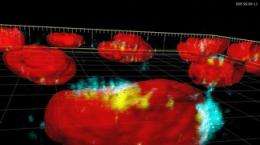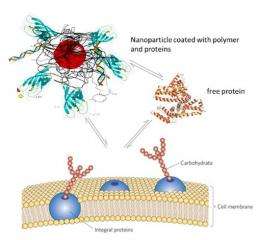Tackling tumors with iron oxide

(PhysOrg.com) -- Detecting cancer cells and destroying them, injecting drugs with extreme precision into diseased cells in the human body – these are just two examples of what EPFL scientists are attempting to accomplish using iron oxide nanoparticles developed in the School’s Powder Technology Laboratory (LTP).
Just 5 – 10 nanometers in diameter (a nanometer is one millionth of a millimeter), the superparamagnetic iron oxide nanoparticles being studied by professor Heinrich Hofmann’s LTP team are promising, because they exhibit magnetic properties when exposed to an external magnetic field. That characteristic is important for certain medical applications, such as diagnosing diseases such as arthritis, locating tumors, and destroying cancer cells in patients.
Detecting cancer
The EPFL scientists are looking at three main applications: diagnostics, treatment and elimination of malignant cells. “In practice, iron oxide particles are already used as contrast agents in Magnetic Resonance Imaging (MRI) in liver tumor cases,” notes Hofmann. “We are studying how to apply this method to all kinds of tumors and if possible to other diseases, like Arthritis. The latter is the goal of a large EU FP-7 project (Nanodiara).” This is how it works: cancer cells have receptors on their surface, a sort of cellular ID. The covering on the nanoparticles is adapted accordingly (via antibodies, for example), so that once they’re injected intravenously, they’ll only attach to the receptors on the cancer cells. And because an iron oxide particle alters tissue contrast when subjected to a magnetic field, it’s thus possible to pinpoint the exact location of cancer cells using MRI. “So far this technique has only been validated for liver tumors, because for each cancer type, surface elements must be added, which change the particles’ behavior. Yet it is quite difficult to understand the behavior of nanoparticles in a complex fluid, such as blood,” he explains.
Targeted treatment
One aspect of the research focuses on an exciting new application: targeted drug delivery to specific cells. “It’s possible for iron oxide nanoparticles to penetrate directly into a cell’s organelles. This property opens up the possibility of delivering a drug right into the interior of a cell,” explains Hofmann. This has clear advantages over existing drug delivery methods. University of Geneva radiology professor Jean-Paul Vallée says:

“In current systemic drug treatments, the drug is not delivered selectively in the body, but absorbed broadly. With this new method, we would be able to avoid certain side effects and deliver the drug only to thecells that need to be treated.”
Destroying tumors with heat
In addition to detecting specific cells and delivering drugs directly into them, iron oxide particles also have the ability to destroy bone tumors hyperthermically. In bone cancer, metastases often develop in the spinal column. One current treatment involves injecting a cement-like substance into the bodies of the vertebrae. Once this polymer-based substance is in the body, it solidifies and thus stabilizes the vertebrae. According to the researchers, if superparamagnetic particles were added to the cement before injection, it would be possible to transfer energy by applying an external alternate magnetic field, thus heating the implant up to 46°C. This procedure would selectively destroy cancer cells in the vicinity, because they are less heat-tolerant than normal tissues. “This method would be less aggressive than lasers, which also burn healthy cells and leave waste materials behind,” adds Hofmann.
For the moment, these three applications are in pre-clinical stage, and are part of several projects involving numerous partners, such as the Lausanne University Hospitals (CHUV), the University of Geneva and the Swiss Center for Electronics and Microtechnology (CSEM), as well as companies like ANTIA or MERCK-Serono.
Provided by Ecole Polytechnique Federale de Lausanne


















